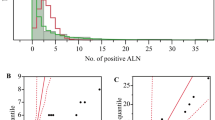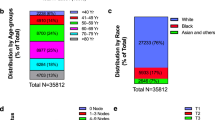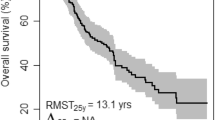Abstract
A method has been developed for determining the mean volume of breast cancer in women at the time of the involvement of the first, second, third,... nth axillary lymph nodes. It has been found that the proportion of patients with axillary involvement as well as the number of involved nodes increase progressively with tumour size. This orderly involvement of axillary nodes is observed in all patient subsets despite a wide spread of tumour volume at the time of invasion of the axillary nodes. This makes it possible to compute for each patient or subset of patients the size of the tumour at the time of the first node involvement, a parameter which characterises the propensity for nodal involvement. A strong correlation was demonstrated between the propensity to lymphatic involvement and the probability of distant dissemination. During tumour progression the capacity for lymphatic spread is on average acquired much earlier than the capacity for haematogenous spread. For tumours of the outer quadrants, the volume at first axillary involvement is smaller than for tumours located in the inner quadrants, whereas the tumour volumes at the time of distant metastatic initiation are equal for the two tumour sites. The discrepancy between these two observations shows that axillary involvement, while being a good index of the propensity of the tumour cells to acquire the capacity for distant spread, is not the cause of this spread. From a clinical point of view, these data show that the prognostic significance of axillary involvement can be further increased by taking into account the size of the tumour. The data suggest that there is a continuum from slow growing disease with late axillary involvement and late distant dissemination to the most aggressive subtype.
This is a preview of subscription content, access via your institution
Access options
Subscribe to this journal
Receive 24 print issues and online access
$259.00 per year
only $10.79 per issue
Buy this article
- Purchase on Springer Link
- Instant access to full article PDF
Prices may be subject to local taxes which are calculated during checkout
Similar content being viewed by others
Author information
Authors and Affiliations
Rights and permissions
About this article
Cite this article
Koscielny, S., Le, M. & Tubiana, M. The natural history of human breast cancer. The relationship between involvement of axillary lymph nodes and the initiation of distant metastases. Br J Cancer 59, 775–782 (1989). https://doi.org/10.1038/bjc.1989.162
Issue Date:
DOI: https://doi.org/10.1038/bjc.1989.162
This article is cited by
-
Prediction of lymph node involvement in breast cancer from primary tumor tissue using gene expression profiling and miRNAs
Breast Cancer Research and Treatment (2011)
-
Parallel progression of tumour and metastases
Nature Reviews Cancer (2010)
-
Impact of tumour size on axillary involvement and distant dissemination in breast cancer
British Journal of Cancer (2009)
-
Breast cancer staging using technetium-99m sestamibi and indium-111 pentetreotide single-photon emission tomography
European Journal of Nuclear Medicine (1997)



